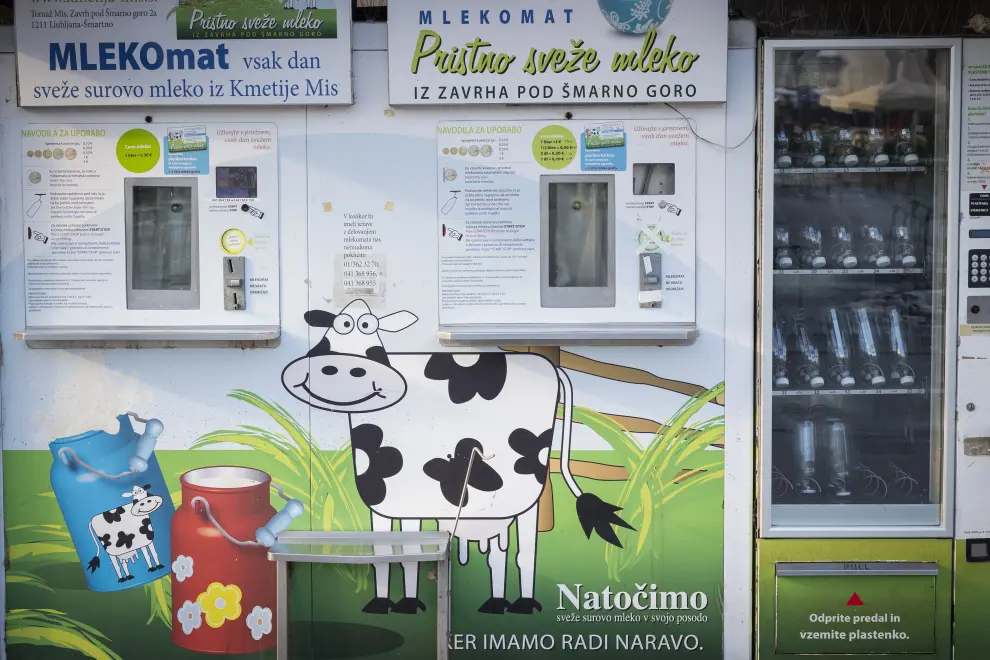Milk, eggs and sausages available around the clock
Getting fresh produce straight from a farm is not always easy, especially in a city, but vending machines are one way of cutting out the middleman with benefits both for the customer and the farmer.
Slovenian farmers set up their first vending machines in 2009. Initially, they sold just fresh raw milk, but the model has since expanded to a range of other food products.
Last year, 106 milk vending machines were registered across the country, along with 82 machines vending eggs, 38 vending cheese, 54 vending meat products and 58 selling other produce.
The Agriculture Ministry says the number of milk vending machines has decreased somewhat in the past three years, as the number of those selling dairy, meat and other foodstuffs has increased.
Milk dispenser as an attraction
Although such machines are not something unique to Slovenia, the milk dispenser in Ljubljana's central market has turned into a kind of a tourist attraction.
The machine is where the locals and visitors can buy full-fat fresh raw milk supplied daily from a dairy farm at the foot of the Šmarna Gora hill, Ljubljana's most popular hiking spot.
Due to inflation, the price has gone up quite substantially, currently at €1.3 per litre. Glass and plastic bottles are also available and it is possible to buy as little as one decilitre of milk. Customers can also buy a pre-paid card and get 2 litres free.
A milk vending machine at Ljubljana's central market. Photo: Bor Slana/STA
Direct sales took off across the EU after the adoption of a package of legislation on food safety, registration of establishments, direct marketing and the linking of rural and urban populations, Gabrijela Salobir from the national Agriculture and Forestry Chamber has told the Slovenian Press Agency (STA).
While the initial cost of buying a machine is high, farmers can get much more per litre than they get when they sell their milk to dairies.
Still, farmers say that apart from the cost of buying the machine, there are also costs and work involving the daily maintenance of the machines.
Jamšek Farm happy with feedback and sales
One of the first farms to set up a milk vending machine in 2009 was Jamšek from Moste near Komenda, north of Ljubljana. Today, the farm operates six milk vending machines, including four in Ljubljana.
They sell about one third of the milk they produce at vending machines, at 90 cents a litre, and the rest to a dairy, where they currently get 48 cents per litre.
"We knew our milk is tasty and of good quality and we dared going into direct marketing," Nada Jamšek told the STA about why they opted for a vending machine.
Today they have one person employed specifically to run their six milk dispensers, because, she says, there is a lot of work involved.
She is happy that they are getting a lot of positive feedback from customers and that milk vending machine sales are going up slowly but steadily.
"The customers are not just those who used to get fresh raw milk from a farm, but also a lot of young families," Jamšek said, revealing the initial cost of the milk dispenser is currently around €30,000.
Pros and cons
Produce vending machines are located in urban and rural areas, often at tourist sites. They are permanently accessible, bringing the countryside closer to the city, and offering top quality foodstuffs, Salobir says about the advantages of the dispensers.
On the downside, some of those who operate them encounter problems such as break-ins, intentional destruction of the machines and money being stolen from them.
According to the national Statistical Office, Slovenian dairy farms produced just over 625,000 tonnes of cow milk in 2022. They sold 92% of that milk to dairies and other middlemen.
Of about 11,300 dairy farms, about 4,400 sold their milk on, while the remaining 6,900 used the milk they produced for feed and their own consumption.
While data on how much milk is sold at vending machines is not available, the Dairy Association at the Chamber of Commerce and Industry estimated a few years ago that about 2% of the milk produced is sold in that way.
Good compliance with food safety standards
Milk dispensers and other vending machines are retail establishments that are required to be registered with the Food Safety, Veterinary Sector and Plant Protection Administration (UVHVVR).
The operator needs to comply with hygiene and food temperature control requirements, meet microbiological criteria for foodstuffs and other standards.
Depending on the type of food sold, operators need to have registered primary food production, such as milk, honey or egg production, and registered or approved production of dairy and meat products, etc.
The administration performs oversight of milk vending machines and other such machines, with inspections carried out both based on the regular annual control plan, and based on complaints, media tip-offs, or referrals from other authorities. So far inspectors have not detected any major breaches.





